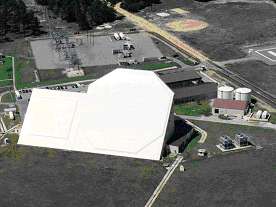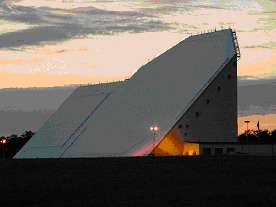



MISSION
The AN/FPS-85 Phased Array Space Surveillance Radar provides space situational awareness for U.S. Strategic Commandís space control mission area. It is one of 29 sensors that comprise the global Space Surveillance Network (SSN), and is the only phased array radar dedicated to space surveillance. It collects over 16 million observations of satellites per year, accounting for 30% of the SSNís total workload.
Data from the system is forwarded to U.S. Strategic Commandís Joint Space Operations Center at Vandenberg Air Force Base, California and the Alternate Space Control Center at Dahlgren, Virginia.
FEATURES
The unique aspect of this radar is the phased array antenna technology. Unlike a mechanical radar, which must be physically aimed at an object in space to track and observe it, the phased array antenna is steered electronically by controlling the timing, or phase, of incoming and outgoing signals. This increases capabilities and decreases response time which allows near simultaneous tracking of multiple targets throughout the systemís area of coverage.
The AN/FPS-85 can detect, track, and identify up to 200 satellites simultaneously. The maximum beam deflection is 60 degrees on either side of the antenna center line which provides 120 degrees azimuth of azimuth coverage. The antenna is inclined +45 degrees for scan coverage of +3 to +105 degrees elevation. Generating a combined output of 32 megawatts, the AN/FPS-85 is the most powerful radar in the world and is the only phased array radar capable of tracking satellites in deep space orbit. The radar can track an object the size of a basketball at a distance of more than 22,000 nm.
BACKGROUND
The AN/FPS-85 radar is employed by the 20th Space Control Squadron (20 SPCS) at site C-6 on Eglin Air Force Base. Located on the gulf coast in Florida`s northwest panhandle, the squadron is a geographically separated unit of the 21st Space Wing, Peterson Air Force Base, Colorado.
Radar construction began in October 1962 and testing was scheduled for May 1965; but four months prior, the building and all equipment were destroyed in a fire caused by arcing electrical equipment. The Air Force took ownership of the site in September 1968 with the 20th Surveillance Squadron (20 SURS) as the primary operator.
Space operations began in February 1969. Initially designed to track satellites, new software installed in 1975 enabled the unit to track submarine launched ballistic missiles (SLBMs). This became the unitís primary mission, while space surveillance became secondary. From 1971 to 1984 the 20 SURS served as the Alternate Space Surveillance Center, providing computational support to the Space Surveillance Center at Cheyenne Mountain AS, Colorado. If the need arose, the squadron could assume command and control of worldwide SSN.
In 1979, the 20 SURS was renamed the 20th Missile Warning Squadron (MWS) and four years later, with deactivation of Strategic Air Command, the squadron was transferred to Air Force Space Command. During this time, the AN/FPS-85 was the proving ground for development of phased array radars designed specifically for early warning of SLBM attacks. These PAVE Phased Array Warning System radars assumed missile warning responsibilities from the 20 MWS and in 1987, the unit returned to its original mission of space surveillance with a corresponding name change to the 20th Space Surveillance Squadron.
In February 2003, the unit was again re-designated, this time as the 20th Space Control Squadron (20 SPCS). In October 2004, a detachment was activated under the 20 SPCS at Dahlgren, Virginia and the unit assumed control of the U.S. Navyís AN/FPS-133 Space Surveillance Radar Fence and the Alternate Space Control Center. Nearly 40 years after operational acceptance, the unitís mission is more robust and critical than ever.
GENERAL CHARACTERISTICS
Primary Function: Space surveillance and reconnaissance. All weather, day and night detection, tracking, and identification of manmade objects in Earth orbit.
Dimensions: Total Length - 318 feet, Total Height - 143 feet, Total Floor Space - 250,000 square feet, Volume of Radar Building - 2,500,000 cubic feet.
Weight: Structural steel - 1,250 tons, Concrete - 1,400 cubic yards.
Air Conditioning Equipment: Three 500-ton chillers with two cooling towers.
Electrical Power: Prime power generated from commercial sources. Two 250 KVA Uninterruptible Power Supplies (UPS) and three emergency diesel generators - 500 KW and two 400 KW - provide backup facility power.
Transmitter Array: 5,928 transmitter antennas and 5,184 transmitter modules generating 32 megawatts of combined power.
Receiver Array: 19,500 receiver antennas and 4,660 receiver modules.
Computer Room: Two IBM ES-9000 mainframe computers, two Radar and Interface Control Equipment (RICE) cabinets, and two SunSparc workstations.
Communications Equipment: Two Message Distribution Terminals, four medium speed printers, one magnetic tape unit, cryptographic equipment, patch and test equipment, secure voice equipment, and a satellite earth terminal.
Crew: Three Military and three DoD Civilians - Crew Commander (Officer), Crew Chief (NCO), Space Console Operator (Airman), Radar Maintenance Technician (DoD Civilian), Computer/Communications Center Operator (DoD Civilian), and Motor Control Center Operator (DoD Civilian).
Date Operational: January 1969; deep space capable in 1988.